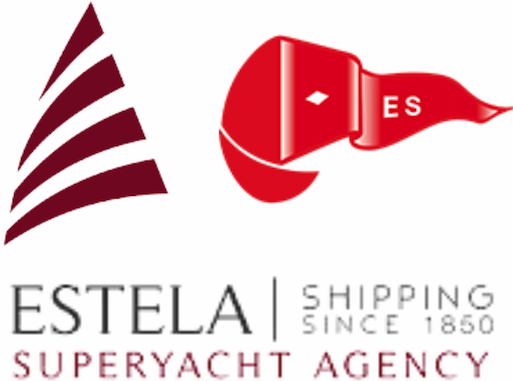(Updated 30 September, 2025)
The transatlantic yachting season is upon us and crew with B1/B2 visas will be in especially great demand.
If you don’t have yours already and are hoping to winter in the Americas, West Indies and the Caribbean, here’s what you need to know…
The ‘B1/B2’ visa
Non-immigrant visas for entering US territory temporarily are classified ‘B-1’ for business, ‘B-2’ for pleasure, or ‘B-1/B-2’ for a combination of both. Valid for up to 10 years for stays of up to six months, it is not specifically designed for yacht crew, but it is the most appropriate class of visa for the industry, says the US State Department.
NB. DO NOT apply for the C-1 crewmember visa, as this is designed for other seafarers.
Work restrictions
Following a COVID-era tweak to the rules, non-US crew can work on foreign or US-flagged yachts in US waters, though NOT employed directly by a US employer or on a US-registered payroll. US taxation laws for foreign nationals are a world of pain anyway, so this is always best avoided in any case.
Note that working, or accepting a job, while in the US on a holiday visa (B-2) is illegal and will get you deported if caught. This is technically also the case throughout the EU, though is generally not enforced. The US is less forgiving, so should you happen to be offered a job on board while ‘vacationing’ in the country, you will need to leave the US as a tourist (B-2) and re-enter as a worker on your B-1 visa, with the relevant boat papers. You may register with crew agencies, etc, while on holiday, but you can not officially accept the job while in the country as a tourist; you must exit first.
Unlike in the EU, you may not technically step off one foreign-flagged boat in US waters and join another back-to-back. It is a grey area that is best avoided by exiting the US and re-entering with fresh boat papers and the commensurate documentation.
Plan ahead
Note that with effect from 6 September 2025, it is no longer possible to ‘shop around’ for earlier or more convenient appointments outside your country of nationality or residence. This reduces your options considerably, as you will only be able to apply where you are legally domiciled.
A list of waiting times by location for (B1/B2) visa appointments can be found here >> https://travel.state.gov/content/travel/en/us-visas/visa-information-resources/global-visa-wait-times.html
How to apply
- Complete the application form (DS-160) and make an appointment at the nearest US embassy or consulate in your country of nationality or residence. The complete list of consulates is here: https://travel.state.gov/content/travel/en/us-visas/visa-information-resources/list-of-posts.html while official appointment waiting times can be found here: https://travel.state.gov/content/travel/en/us-visas/tourism-visit/visitor.html. While published waiting times for appointments can be extremely long, it is possible for seafarers to request an urgent appointment at the end of the online application process.
- The embassy or consulate at which you apply will be able to retrieve your DS-160 form using the barcode on your DS-160 confirmation page, which you must bring to the visa interview. For example, you intend to apply for your visa at the US embassy in City X, so you select City X as the location where you will submit the application. You may instead travel to City Y in the same country* for an earlier or more convenient appointment. With effect from September 2025 applicants can not apply in any country other than their country of nationality or legal residence.
- A list of 17 nationalities for whom US visa-issuance is unavailable in their home country (including Ukraine and Russia) can be found here: https://travel.state.gov/content/travel/en/News/visas-news/adjudicating-nonimmigrant-visa-applicants-in-their-country-of-residence-sep-6-2025.html
NB. It is crucial in your application to establish that you do not intend to abandon your residence abroad, as per rule 9 FAM 402.2-5(C)(5) (U) of the Foreign Affairs Manual. Usually, this will be ongoing property/residential ties, family ties, bank accounts and ongoing payments, car papers, and any other permanent connections to your country of residence.
- Pay the non-refundable application fee of US$185. For some nationalities, additional fees can apply.
- Print the application form and payment confirmation, and bring them with you to the appointment, as well as your passport (valid 6+ months beyond your stay) and two passport photos that meet the required format. Also bring any and all available supporting documentation showing the purpose of your visa application, such as boat papers, Seaman’s Book, employment letter or contract, yacht itinerary, proof of seafaring work history, future travel planned/booked and, importantly, proof that you can afford all expenses for the duration of your visit. If you have an old passport that shows a problem-free travel history (ie. no revoked visas or overstays, etc), bring that too. If in doubt, get an agent to check your documentation.
- It is not necessary to have a job lined up to apply for a B1/B2, but it can help. If you happen to be joining a commercial charter yacht, it’s an idea not to volunteer the name of the yacht, or at least, request an offer letter that doesn’t mention the boat’s commercial status. By letter of the law, “Yacht crew who will provide services on board a recreational vessel and who are able to establish that they have a residence abroad which they do not intend to abandon, regardless of the nationality of the yacht, are classifiable B-1”. In other words, the B-1 is aimed at crew on private vessels. Even though ‘commercial yachts’, as we say in yacht-speak, are considered private, it’s worth avoiding any confusion.
Success in an individual assessment can never be guaranteed, of course. Should you somehow be denied at the first attempt, it is possible to reapply, but it’s best to be over-prepared than fall short of the requirements. Bring everything with you; from all the official forms and documentation to photos of your pet animals staying behind. The US is convinced that all foreigners want to move there, so it’s down to you to disabuse them of that conviction.
After the interview
- Of course, an important consideration is how long it will take the embassy to issue the visa, if approved, particularly if you need your passport for travel in the meantime. Within the Schengen Area, you may be able to travel with only a recognised ID card, if you have one, though ideally you will want to retain your passport to return to the boat or place of residence while you wait.
- Not all US embassies require B1/B2 visa applicants to leave their passports behind after the interview, though most do. Whether or not you are required to leave your passport behind will depend on the specific embassy or consulate where you are applying for your visa. Check the website of the embassy or consulate to find out their specific requirements.
- If you must leave your passport behind, you will typically be able to pick it up within a few days or weeks, once your application has been processed. Some embassies may offer to courier the passport back to you, hopefully with the visa granted.
- If you are unable to leave your passport behind, you can request an exception, though these are not always granted. To increase your chances of success, stress the urgency and importance of your visa requirement, and be super polite. And bear in mind that you will need to return to collect it.
Here are some tips for dealing with the passport requirement:
- Check the website of the embassy you are applying to, to find out their specific requirements well in advance
- If you must leave your passport behind, consider your accommodation and/or travel arrangements to and from the embassy
- If you are unable to leave your passport behind, contact the embassy or consulate to request an exception (ask very nicely!)
**Check your visa thoroughly to ensure that all details are correct**
Annotations
For reasons best known to themselves, some US visa officers will sometimes annotate the visa, stipulating the name of the boat for which the B-1 visa is valid. Should you be unfortunate enough to encounter an unhelpful official who inserts such an annotation — in the comments section underneath the issue date on the visa — this means that you will be unable to join any other boat with this visa and will require a new one before travelling to the US for another vessel. Anecdotally, officials in Madrid are particularly keen on this annotation. If you have experienced similar elsewhere, please do tell us at palma@estelashipping.net.
If in any doubt about the application process, the documentation required for the interview and the interview itself, it is explained in these useful Youtube videos by GrayLaw solicitors in California. They are not specifically aimed at yacht crew, but they are extremely clear and will help you navigate the process:
How to apply: https://youtu.be/dr3XSu1LvPk
Documents to bring to the interview: https://youtu.be/QAHvXxMPYPQ
If you don’t already have a contract, but are job hunting, it’s a good idea to print out some job advertisements from some recruiters’ websites (not social networks) listing a B1/B2 Visa as a requirement for the same type of jobs you are applying for. (hat tip to Lars Molin for this suggestion!)
Also print and bring along this letter by the Marine Industries Association of South Florida. It is addressed to US immigration officers unfamiliar with the yachting industry, explaining why ‘B1/B2’ is the most appropriate class of visa for yacht crew.
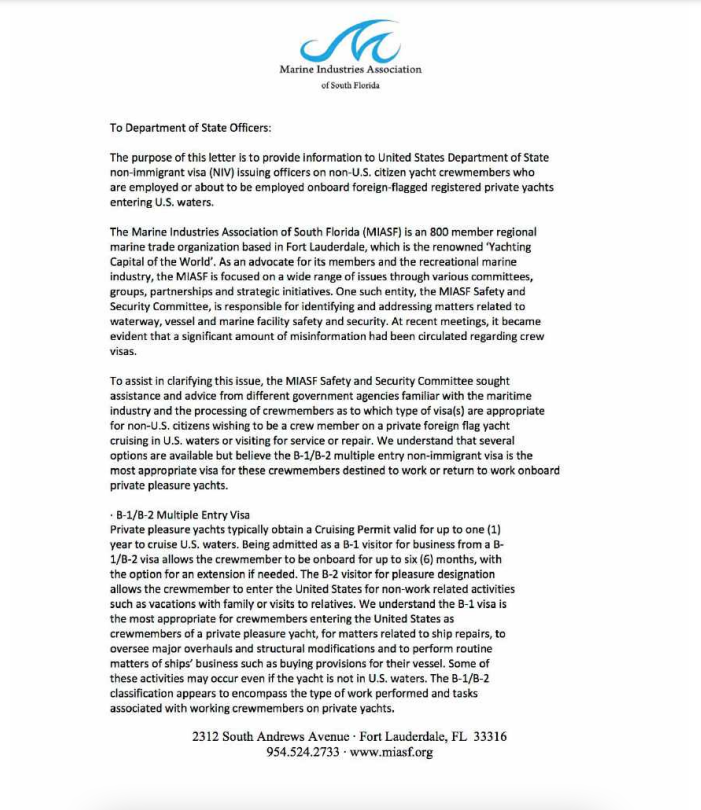
The interview itself, the 8 most common FAQs and tips: https://youtu.be/ae4d4l_a0fA
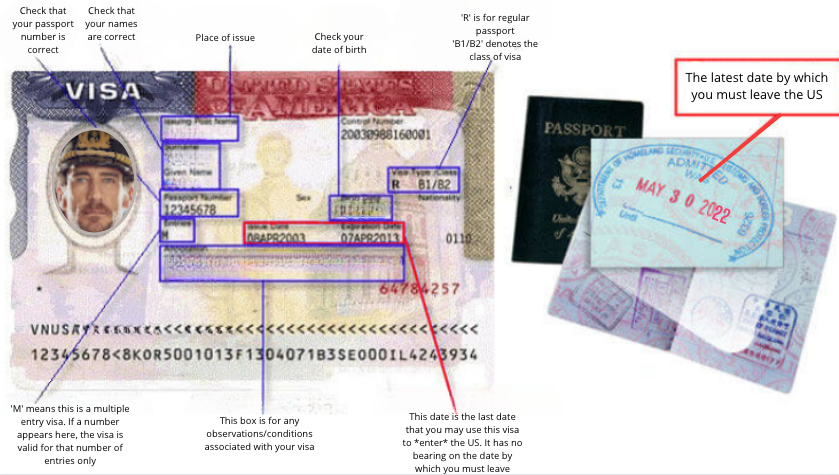
Entry and exit
Actual possession of a valid B1/B2 visa is not a guarantee of entry, as immigration officials still need to be satisfied with the purpose and length of your visit, so you should always travel to the US with the supporting documentation outlined above. Immigration officials in South Florida are used to yacht crew coming through, so denials of entry are rare here. If the boat you are joining is undergoing an extensive yard period, it helps to have a letter from the yard indicating the length of time and nature of work to be carried out.
Many boat owners use third-party crew agencies that serve as foreign employers and process payroll outside of the US, in which case immigration lawyers recommend carrying a short letter from the employer outlining the points clearly.
As ever, valid visa status and correct stamping of a passport are the bearer’s responsibility, so diarise expiry dates, keep a count of your number of days spent in the country and apply for visa renewal in good time, which you can do from six months out. The US is zero-tolerant to overstaying, so please ensure that you don’t fall foul of the authorities.
Avoid making unnecessary short trips to eg. The Bahamas or the Caribbean, as such visits may raise suspicions with immigration officials if staying on a B1 (work) visa. If the trips are work-related, carry any relevant documentation to justify your exit/re-entry.
Need a history of your arrivals and departures into and out of the US?
International travelers visiting the United States can apply for or retrieve their I-94 admission number/record (which is proof of legal visitor status) as well as retrieve a limited travel history of their US arrivals and departures.
https://i94.cbp.dhs.gov/help#How-to-Access-and-Print-Your-Form-I-94-Arrival-Departure-Record-using-an-A-Number-Alien-Registration-Number
Here, you can view your US arrival and departure history for the past 10 years (certain types of travel history may not be provided). Please know, this travel history is a tool to assist you but not an official record for legal purposes.
Already visiting and need proof of visitor status?
A traveller lawfully admitted into the US may look up their most recent Form I-94 going back to 1983 for most classes of admission, and indefinitely for certain classes, such as diplomats and those admitted under the Compacts of Free Association. This is considered your lawful record of admission and if someone requests your admission information, this is the form you would provide. https://i94.cbp.dhs.gov/search/recent-search
Is ESTA a suitable alternative?
We have been asked a number of times about using ESTA as a more-easily obtainable alternative. It can work, especially for short-stay rotational crew members, but there are limitations to bear in mind.
An ESTA would cover you for work trips of up to 90 days and, because it is multi-entry, it can cover you for trips to the Bahamas and back. Just as with the B1/B2, your employer cannot be a US entity with an ESTA. They are valid for up to two years, or until your passport expires, so the B1/B2 is obviously preferred.
There are agents and seafarers who claim that ESTA is valid only for travel via commercial aircraft or bonded vessel and cannot be used on private (or charter) yachts. There is no definitive information about this to be found on US government websites (which focus on passengers rather than crew), so we asked the US Customs and Border Protection section of the Department of Homeland Security for clarification. They replied thus:
“Thank you for contacting the U.S. Customs and Border Protection (CBP) Information Center.
Crew are supposed to have a B1 or B1/B2 visa to enter the US by private yacht. You have to contact the CBP port where the yacht will enter the US to ask if the crew may be allowed to re-enter after a short trip to the Bahamas if they recently entered the US by air and have a current 90 day admission period.”
In other words, you’re supposed to have a B1, but as long as you have documentation to substantiate your travel history, you should be alright. Just make sure that the boat obtains prior approval before arrival.
More information about ESTA can be found here.
US B1/B2 visa revocations affecting yacht crew
3 September 2025
There have been recent reports of multiple yacht crew members holding valid US B1/B2 visas experiencing unexpected revocations and even removal orders.
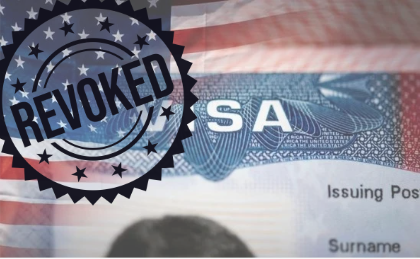
Key Incidents:
- Two British nationals had their 10-year B1/B2 visas revoked with four years remaining on their validity
- One individual was denied re-entry at the airport despite having previously entered the United States without incident
- Revocations occurred without prior warning, with notifications sent via email to personal addresses
- Filipino crew on ships have had visas revoked upon arrival (by sea) to the US, having had their phones inspected
Reported Factors:
- Immigration authorities appear to be conducting retrospective social media reviews
- Particular scrutiny is being applied to posts suggesting work-seeking behaviour in the US
- Mobile device searches at ports of entry are reportedly becoming more frequent
- Crew members of various nationalities have experienced revocations
The BBC reports that US authorities are reviewing 55 million visa holders for potential violations, suggesting a systematic approach to visa compliance enforcement.
Industry Impact:
- Freelance crew members report increased difficulty in obtaining or maintaining legal status
- Established crew with long-standing visas are experiencing unexpected revocations
- Legal representation is being sought by affected individuals, as standard ESTA applications are reportedly not available as an alternative
The situation has creates considerable uncertainty about US air- and sea-port access and crew mobility.
Precautions:
There is little that can be done to avoid having one’s visa revoked for seemingly no reason, though if travelling to the US, consider the following steps:
a) CBP officials tasked with reviewing (B1/B2) visas may have no understanding of yachting at all, nor that the B1/B2 visa is the most appropriate visa for yacht crew. As such, consider removing any reference to yachting from your social media profile(s).
b) Remove any content from your profile(s) that may suggest you are unsuitable or ineligible for a US visa. Bear in mind the current sensitivity among US officials towards criticism of the politics of the government and its leadership.
c) Consider leaving your phone behind and travelling with a ‘burner’ phone or a wiped handset. The same goes for any other device with access to your social and professional online presence, as well as any media or files referring to your line of work.
d) Consider not travelling to the US at all under the current climate.
What to do if your visa is revoked:
- Do not reapply for any US visa without first consulting an immigration lawyer. An attorney specialising in maritime and immigration law can review your case, determine the exact grounds of ineligibility, and advise on the possibility of applying for a waiver (Form I-192) if you received a ban.
- Remain calm and professional. Do not argue with the CBP officer, it will not help
- Understand the reason. You have the right to ask for the specific reason for the revocation. It will often be coded under INA 212(a)(6)(C)(i) for misrepresentation, which is a permanent ban unless a waiver is approved.
- Withdrawal of Application (Form I-275*) vs. Expedited Removal: If given the choice, ‘Withdrawal of Application for Admission’ is vastly preferable to an ‘Expedited Removal Order’. Withdrawal allows you to leave immediately and avoid a formal 5-year bar to re-entry.
*Receiving a Form I-275: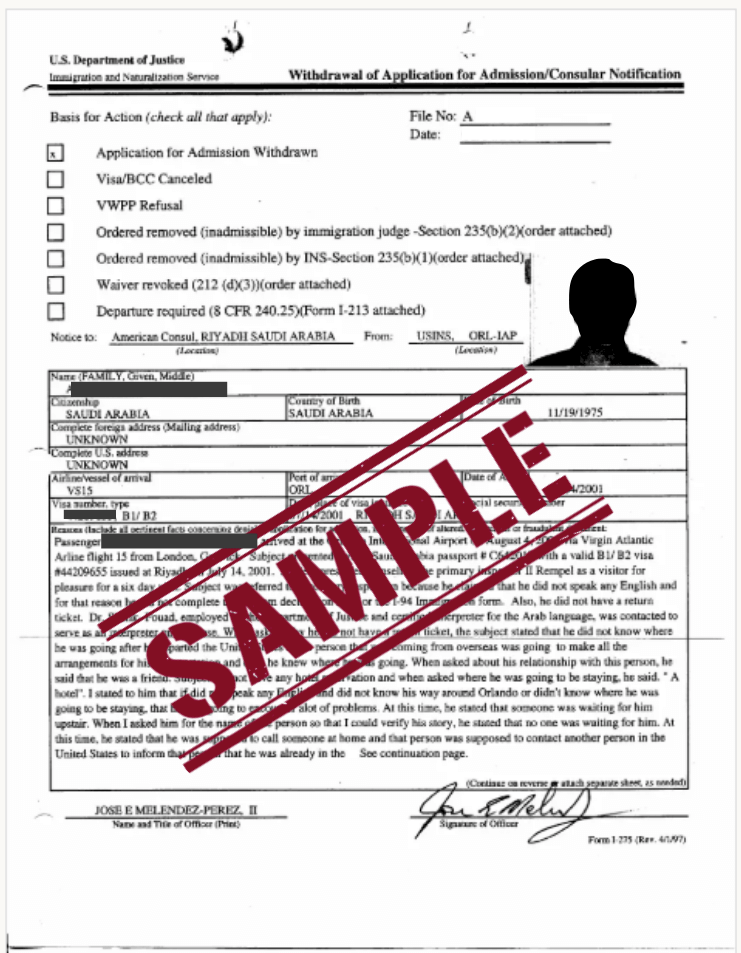
If you’re applying for entry at a US port of entry and a CBP officer determines you are inadmissible under the Immigration and Nationality Act (INA), you may be given the option to withdraw your application for admission by signing Form I-275.
This is preferable to being formally removed from the country and a receiving a lengthy ban from re-entry. It is important to understand the reason for being refused admission before trying again or applying for another visa. It’s advisable to consult an immigration lawyer before reapplying.
If you have any questions or would like our assistance with your application, please get in touch on +34 971 72 25 32 or email palma@estelashipping.net
